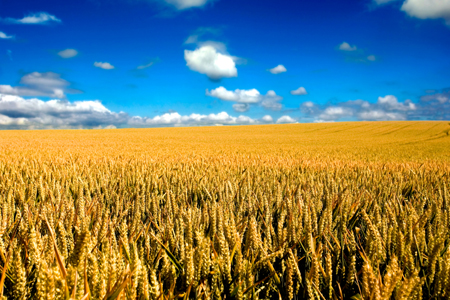 (Reuters) – A drop in corn prices to a three-year low this autumn has caused U.S. farmers to contemplate boosting their wheat plantings, a shift that would stem a decades-long trend toward corn.
(Reuters) – A drop in corn prices to a three-year low this autumn has caused U.S. farmers to contemplate boosting their wheat plantings, a shift that would stem a decades-long trend toward corn.
Wheat futures have surged this autumn, hitting a 4-1/2 month high as planting of the winter wheat crop kicked into high gear in the U.S. Plains. Prices for corn fell just as wheat was rallying, a rare divergence between the two markets that typically move in the same direction.
The U.S. Agriculture Department will not provide its first look at recently seeded wheat acreage until early next year but the price action of the past few months has farmers scrambling for ways to boost profits, analysts and growers said.
“We are down a little over $3 (per bushel) from where we were last year on cash price,” said Brian Linin, CFO at Frontier Ag Inc, an agriculture cooperative in northwest Kansas. “Guys are a little reluctant to invest a lot of dollars in fertilizer to try to grow corn next year if it is going to be $4 corn.”
Linin, who also is a farmer himself, said wheat is a more dependable crop, and the sharp price drop in corn has many growers craving certainty.
Wheat and corn futures traded in opposite directions from Sept. 23 to Oct. 29–with corn dropping 4 percent and wheat rising 6.1 percent. That was the longest stretch of time the two markets have shown a negative correlation since a 47-day stretch in the autumn of 2001.
In October, the disparity in the direction of the two markets reached minus 3/4, a negative correlation last seen six years ago, in November 2007. The last time it was bigger was in August 2003, when the correlation between corn and wheat trading was minus 7/8. The moves in opposite directions blew out the spread between the two commodities to $2.64-1/4 per bushel premium for wheat, the biggest since August 2010.
After corn harvest finishes, grain bins will be overflowing, creating a surplus of corn that the market will have to burn off before prices can rally and reversing the tight supply situation that end users have suffered through in recent years.
The USDA said on Friday that corn stocks would stand at 1.887 billion bushels by the end of the 2013/14 crop year, up from 824 million a year earlier and the biggest supply in eight years. Meanwhile, wheat supplies were pegged to hit a six-year low by the end of the marketing year.
“These past two or three years, you have had a true issue with the corn balance sheet being very, very tight and wheat being adequately or even over supplied, said Sal Gilbertie, president of Teucrium Trading, which runs single-commodity exchange-traded funds (ETFs) devoted to grain and oilseed contracts. “We literally in one season switched that around.”
To be sure, farmers in the largest corn-growing states such as Illinois and Iowa will be reluctant to give up some of that acreage in favor of wheat. But farmers in places such as Kansas and North Dakota, which experienced big shifts to corn in recent years, may switch some fields back to wheat.
U.S. corn acreage has risen 24.1 million acres (9.8 million hectares) to 97.4 million acres during the last 20 years while wheat plantings have fallen 16.0 million to 56.2 million acres.
In Kansas, the largest wheat-producing state in the United States, farmers seeded 9.5 million acres of wheat last year, down 1 million acres from 10 years ago, and 2.6 million less than farmers in that state seeded 20 years ago. Corn acreage in Kansas has grown 2.5 million acres during the same time period.
But corn has not provided the bountiful harvests in many parts of the Plains states, causing farmers to question why they made the switch.
“Corn … they have struggled with it a couple of times now because of the drought, so things are looking promising for wheat,” said Jason Lamprecht, a senior statistician at the USDA’s National Agricultural Statistics Service office in Topeka, Kansas.
Good rain across Kansas this autumn has given farmers the best planting conditions for winter wheat in years.
“They are not rookies as far as planting wheat,” said Shawn McCambridge, grains analyst at Jefferies Bache. “That is an easy switch for them.”




